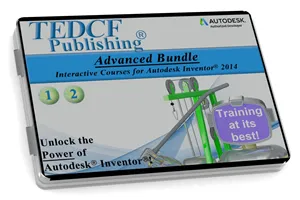2 Courses
Over 20.7 hrs Video Instruction
Course-1: Solid Modeling
9.8 hours of instruction
The Autodesk Inventor 2015: Solid Modeling course is the first course in the series designed to assure your models and assemblies are structurally sound and modifiable. This course focuses on practical methods of creating models. You'll use all the commands in the part environment while you learn best practice. Each lesson progressively builds your skills. So it doesn't matter if you're a beginner or advanced user. You will learn best practices from this course.
If you're an advanced user you can skip the first few lessons because it introduces you to the Inventor User Interface. You'll practice creating a sketch, and you'll learn where to find the commands. Once this is done you will begin building a strong foundation of skills that assure your models are functionally sound. If you've worked with Inventor you know this is important. Poorly constructed models may need to be scrapped and reconstructed.
During your training journey you will practice using all the feature commands. You'll learn how to use parameters, how and when to share sketches, various construction strategies, and much more. This course covers everything you need to create professionally sound models. Look through the list of lessons to learn more.
Lessons:
Introduction
Getting Started
The Open Dialog Box
Create a Project
Overview of the User Interface
The Heads Up Display
Create a Sketch
Sketch Constraints
Extruding a Profile
The In-Canvas Display
Mini-Toolbar Customization
The Marking Menu
Marking Menu Customization
Editing Profiles
View Cube and Navigation Bar
Sketches vs Profiles
Solid Bodies
Template View Orientation
Constraining Profiles
Creating Profiles From Solids
More Mini-Toolbars
Default Work Planes
Revolve a Feature
Trick for Constraining Sketches
Constraining the Axis of Revolution
Projecting Geometry
Creating Work Planes
Extruding to a Plane
Sharing Sketches
Construction Lines
Centerlines
Mirroring Features
Circular Feature Array
Rectangular Feature Array
Application Options
Creating Holes
Placing Holes Part I
Placing Holes Part II
Creating Hole Patterns Part I
Creating Hole Patterns Part II
Threaded Holes
Advanced Thread Settings
Finishing Features
Clearance Holes
Pipe Thread Holes
Fundamentals of the Shell Command
Using the Shell Command
3D Construction Stage I
3D Construction Stage II
3D Construction Stage III
Breaking Rules
Ribs Parallel to Sketch
Ribs Perpendicular to Sketch
Draft and Ejector Pads
Control Vertex Splines
Bridge Curve Splines
Interpolation Splines
Constraining Splines
Tweaking Splines
Bowties
Fit and Tension
Sweep
Sweep Path and Guide Rail
Sweep Path and Guide Surface
Introduction to 3D Sketches
Using 3D Sketches
3D Splines and Coils
Mirroring Sketch Geometry
Editing Mirrored Sketches
Automating Patterns
Linear Slots
Arced Slots
Lofts
Loft Conditions
Loft Transition and Point Mapping
Lofts with Rails
Rails on Cylindrical Lofts
Tricks for Round Spline Sweeps
Square Sweeps
Centerline Lofts
Skin Bodies
Adjusting Color
Closed Loop Lofts
Area Lofts
Loft Strategies
The Lip Command
Coils and Springs
Parameters and Tolerances
Linking Excel Spreadsheets
Threads
Importing Points
The Bend Part Command
Bending Conical and Loft Parts
Direct Edit Move
Direct Edit Size
Direct Edit Rotate
Direct Edit Delete
The Emboss Command
The Boss Command Part I
The Boss Command Part II
Ribs on Bosses
The Rest Command
The Grill Command
Rule Fillets
Replacing and Splitting Faces
The Sculpt Command
Freeform TSpline Basics
Freeform Symmetry
Detailing Freeform Features
Modifying and Stitching Surfaces
Patch Stitch IGES Files I
Patch Stitch IGES Files II
2D Equation Curves
3D Equation Curves
Conclusion
Course-2: Assemblies and Advanced Concepts
10.9 hours of instruction
The Assemblies and Advanced Concepts course is the second course in the series. It shows you advanced ways of creating models as well as tips and tricks that assure your models are structurally sound. Some of these tricks significantly reduce construction time. You'll also learn standard and advanced methods of creating assemblies. This course will show you how to make your models and assemblies bulletproof.
You'll practice deriving parts from other parts, creating scaled and mirrored parts, as well as parts that adapt to changes in other parts. If you have a series of common parts you can create an iPart generator to generate all the parts in the series. This course shows you how it's done.
The Design Accelerator is covered in detail. You'll create bolted connection, gears, shafts and springs, but you'll also learn a unique method of creating springs developed here at TEDCF Publishing. Most people believe you can't make a closed and ground helical spring that actually compresses in an Inventor assembly. This course shows you how it's done.
You'll learn how to create assemblies from 2D layouts. You use Bottom Up Design to create assemblies. Top Down Design, which is the preferred method, is also covered in detail. You'll also learn how to merge the design methods to get the results you want.
iFeatures, iParts, the Contact Solver, Presentations, Kinematics, … There's too much in the course to list here. Read through the list of lessons. It's packed with tips and tricks that will make you an extremely advanced user.
Lessons:
Introduction
Sketch Origin Node
Using and Creating Templates
Creating Derived Parts
Editing Derived Parts
Intro to the Assy Environment
Degrees of Freedom
Driving Constraints
Explicit Reference Vectors
Adaptive Parts and Sketches
Adaptive Constraint Strategies
Creating Adaptive Parts I
Creating Adaptive Parts II
Using Constraint Strategies
Removing Adaptivity
Driving Adaptive Assemblies
The Content Center
The Symmetry Constraint
Ball Joints
Planar Joints
Joint Alignment Details
Cylindrical Joints
Slider Joints
Rotational Joints
Rigid and Automatic Joints
Mirrored Assemblies
Mirrored and Copied Constraints
Flexible Assemblies
Copied Assemblies
Pattern Components
Advanced Viewing
Assembly Viewing
Motion Constraints
Animating Gears
Transitional Constraints
Collision Detection
Contact Solver
Checking for Interferences
Creating Compressible Springs
Driving Adaptive Springs
Positional Representations
Creating Presentations
Editing Tweaks
Animating Presentations
iFeature Design
Inserting iFeatures
Reusing Part Features
Advanced iFeature Design
Reducing Dangling Geometry
Creating iPart Factories
iPart Members
Editing the iPart Author
iMates and iParts
Custom iParts
Creating iPart Assemblies
Updating iParts
Threaded iParts
iMates and the Content Center
Identifying and Using iMate Glyphs
Inferred iMates
Scaling Parts
Combining Parts I
Combining Parts II
Subtracting and Splitting Parts
Deleting Faces
Strategy for Splitting Parts
Trick for Measuring Interferences
Prep for Design Accelerator
Bolted Connections
Generating Bearings
Generating Shafts Part I
Generating Shafts Part II
Generating Shafts Part III
Generating Gears
Generating Keyways
Advanced Spring Design I
Advanced Spring Design II
Animating Springs
Working with Large Assemblies
Level of Detail
Shrinkwrapping Components
Skeletal Modeling Introduction
Make Part and Components
Kinematics
Sketch Blocks
Advanced Top Down Design
Blocks and Assemblies
Modeling Techniques I
Modeling Techniques II
Flexible Block Assemblies
Hybrid Design Methods
Alternate Slice Method
Import Assy to Part File
Middle Out Design
Exporting Bodies to an Assembly
Replacing Assemblies
The Assemble Command
Sinusoidal Conical Sweeps
Alternate Split Part Methods
Appearances on Derived Features
Selecting a Design Strategy
Practice with Relationships
Inverted Text
Conclusion

Autodesk Inventor® 2014:
Advanced Bundle
No Installation Required
Watch from any device connected to the internet.

Sale
$84.95 - $169.95
Over 20.7 Hours of Video Instruction
The Autodesk Inventor 2014: Advanced Bundle is strictly a modeling bundle. It teaches both single part and assembly modeling from beginner to professional level. It has 2 courses including Solid Modeling, and Assemblies and Advanced Concepts.
Watch Sample Lessons
Watch the first hour of the Solid Modeling course for Autodesk Inventor 2014.
 Click to Watch!
Click to Watch!